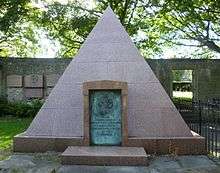Andrew Rutherfurd, Lord Rutherfurd
The Right Hon. Andrew Rutherfurd, Lord Rutherfurd, PC, FRSE (born Andrew Greenfield; 21 June 1791–13 December 1854) was a Scottish advocate, judge and politician.

Life
Rutherfurd was born at Bristo Port[1] (near Greyfriars Kirkyard) in Edinburgh on 21 June 1791 to Janet Rutherfurd[2] and Reverend William Greenfield. In 1799 the family changed their name to Rutherfurd, his mother's maiden name, after his father was disgraced in a sex scandal.[3]
He was educated at the High School in Edinburgh then studied law at the University of Edinburgh. He became an advocate in 1812.
In the 1830s he is listed as an advocate living at 9, St Colme Street, on the Moray Estate in Edinburgh's west end.[4] His house was remodelled by William Notman in 1835, whilst working in the offices of William Henry Playfair.[5]
He was appointed Solicitor General for Scotland from 1837, becoming Lord Advocate in 1839 and Member of Parliament for Leith burghs in the same year. He resigned office in September 1841 on William Peel's accession to power. He was appointed Rector of the University of Glasgow in 1844.
He played an active part in parliamentary proceedings relating to Scotland, and proposed the repeal of the Corn Laws in 1846. He was reappointed Lord Advocate in 1846, and was responsible for legislation amending the law of entail in Scotland in 1848. He served on the Royal Commission on the British Museum (1847–49).[6]
On 2 January 1849 he was elected a Fellow of the Royal Society of Edinburgh, his proposer being John Russell.[7]
He was appointed a Senator of the College of Justice, as Lord Rutherfurd and a Privy Counsellor in May 1851. From 1851 to 1854 he was a Lord of Session.
He died at his home, at 9, St Colme Street, on 13 December 1854.[8] He is buried on Lord's Row, against the western wall of Dean Cemetery, in western Edinburgh, beneath a red granite pyramid designed by William Henry Playfair and built by Stewart McGlashan.[9][10] The monument is inscribed: Uxori desideratissimae contra votum superstes moerens posuit Andreas Rutherfurd, et sibi, MDCCCLII. ("Andrew Rutherfurd, surviving against his will, placed this tomb in mourning to his most beloved wife, and to himself, 1852".)[11]
Family
He married Sophia Frances Stewart in 1822. She died in 1852 and is buried with him. They had no children.
His sister married John Gordon FRSE (1786-1818) father of John Thomson Gordon FRSE (1813-1865)
Galley
 Grave in the Dean Cemetery
Grave in the Dean Cemetery Andrew Rutherfurd and his wife, Sophia
Andrew Rutherfurd and his wife, Sophia_Old_College%2C_Edinburgh_University.jpg) Bust of Rutherfurd, by William Theod Rome (1837) Old College, University of Edinburgh
Bust of Rutherfurd, by William Theod Rome (1837) Old College, University of Edinburgh- Rutherfurd's home at 9 St Colme Street, Edinburgh (centre: blue door)
References
- Edinburgh and Leith Post Office Directory 1793
- Waterston, Charles D; Macmillan Shearer, A (July 2006). Former Fellows of the Royal Society of Edinburgh 1783–2002: Biographical Index (PDF). II. Edinburgh: The Royal Society of Edinburgh. ISBN 978-0-902198-84-5. Archived from the original (PDF) on 4 October 2006. Retrieved 23 December 2010.
- Pisanus Fraxi [Henry Spencer Ashbee], "Index Librorum Prohibitorum: being Notes Bio- Biblio- Icono- graphical and Critical, on Curious and Uncommon Books", London, privately printed, 1877, p. 340
- "Edinburgh Post Office annual directory, 1832-1833". National Library of Scotland. Retrieved 22 January 2018.
- Goold, David. "William Notman". www.scottisharchitects.org.uk. Retrieved 22 January 2018.
- The Life of Sir Anthony Panizzi, Volume 1, by Louis Alexander Fagan, p. 257
- Biographical Index of Former Fellows of the Royal Society of Edinburgh 1783–2002 (PDF). The Royal Society of Edinburgh. July 2006. ISBN 0-902-198-84-X. Archived from the original (PDF) on 4 March 2016. Retrieved 9 May 2018.
- Edinburgh and Leith Post Office Directory 1853-54
- "Andrew Rutherfurd – Edinburgh Drift".
- "Archived copy" (PDF). Archived from the original (PDF) on 16 January 2014. Retrieved 10 June 2015.CS1 maint: archived copy as title (link)
- Rogers, Charles (19 July 1871). "Monuments and monumental inscriptions in Scotland" – via Google Books.
- George William Thomson Omond, "The lord advocates of Scotland: 2d series, 1834–1880", A. Melrose Ltd, 1914, pp. 47–49
External links
- Hansard 1803–2005: contributions in Parliament by Andrew Rutherfurd
- . Dictionary of National Biography. London: Smith, Elder & Co. 1885–1900.
| Parliament of the United Kingdom | ||
|---|---|---|
| Preceded by John Archibald Murray |
Member of Parliament for Leith Burghs 1839–1851 |
Succeeded by James Moncreiff |
| Legal offices | ||
| Preceded by John Cunninghame |
Solicitor General for Scotland 1837–1839 |
Succeeded by James Ivory |
| Preceded by John Murray |
Lord Advocate 1839–1841 |
Succeeded by Sir William Rae |
| Preceded by Duncan McNeill |
Lord Advocate 1846–1851 |
Succeeded by James Moncreiff |